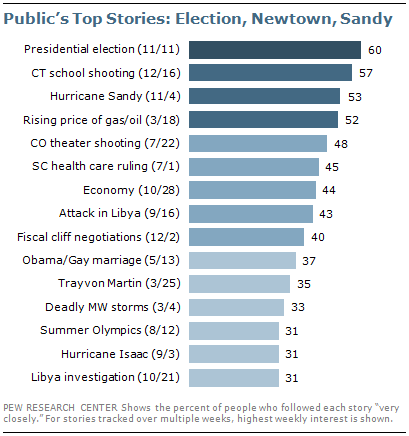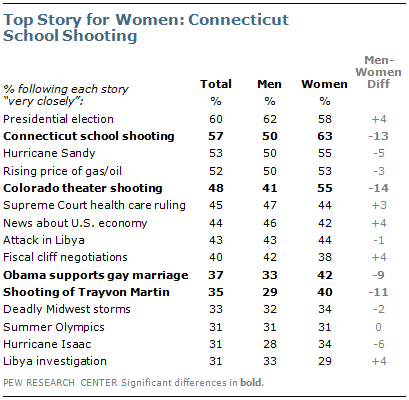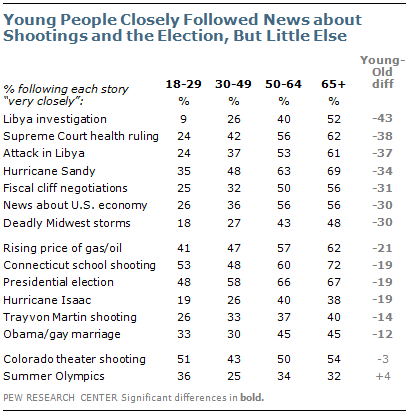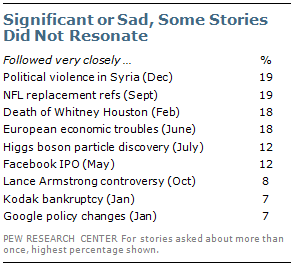The public’s news interests were very much focused on domestic developments this year, with the election outcome, last week’s horrific school shooting and Hurricane Sandy leading the list of the top stories of 2012.
 With the exception of the attack on a U.S. consulate in Libya in September, which became a bitterly debated campaign issue, no foreign news story cracked the list of top stories.
With the exception of the attack on a U.S. consulate in Libya in September, which became a bitterly debated campaign issue, no foreign news story cracked the list of top stories.
The presidential election was the year’s top story, according to Pew Research Center’s News Interest Index, which tracks interest in major stories in a weekly basis. In the days following Barack Obama’s reelection, 60% followed campaign news very closely.
The Dec. 14 shooting at an elementary school in Newtown Conn. attracted nearly as much interest; 57% followed news about the tragedy very closely. Another large-scale shooting this year – this one at an Aurora, Colo. movie theater in July – also drew widespread interest, with nearly half (48%) following this event very closely.
Hurricane Sandy, which hit the East Coast in late October, drew very close interest from 53% of Americans. Though it struck in the final days of the campaign, interest in Sandy surpassed interest in the election that week. Both Sandy and the Newtown shootings attracted overwhelming interest in the Northeast; fully 73% of those in that region tracked Sandy very closely while 70% followed the Connecticut school shootings very closely.
While the election was the year’s top political story, there also was substantial interest in several policy-related stories. Fully 45% of Americans followed the Supreme Court’s ruling on the 201o health care law; the ongoing fiscal cliff negotiations have consistently drawn interest from about four-in-ten Americans, while 37% paid very close attention to Obama’s announcement of support for same-sex marriage in May.
The absence of foreign news from the top stories list, with the exception of the Libya consulate attack, marked a contrast with last year, when several international stories drew broad interest, including the Japanese earthquake and tsunami (the top story of 2011), the killing of Osama bin Laden and the Arab Spring protests.
Gender Gap in Interest in Top Stories
Men and women paid roughly equal attention to most of the top stories of the year. However, higher percentages of women than men followed news about the large-scale shootings in Colorado and Connecticut very closely.
 Fully 63% of women tracked news about the Newtown shooting very closely – making this the top story of the year for women; 58% followed the election very closely. Among men, 62% followed the election very closely, while 50% followed news about the Connecticut shooting very closely.
Fully 63% of women tracked news about the Newtown shooting very closely – making this the top story of the year for women; 58% followed the election very closely. Among men, 62% followed the election very closely, while 50% followed news about the Connecticut shooting very closely.
Women also were more likely than men to follow the shooting in a Colorado movie theater (by 14 points), the shooting death of Florida teenager Trayvon Martin (11 points) and Obama’s expression of support for gay marriage (nine points).
Among the year’s top stories, none drew significantly more interest among men than women. However, far more men than women paid greater attention to a number of other stories throughout the year, including news about Iran’s nuclear program, plans for withdrawing U.S. troops in Afghanistan and sporting events.
Racial Gap in Interest in Trayvon Martin Shooting
 There was a huge racial divide in interest in the shooting of Trayvon Martin, the unarmed black teenager who was shot and killed in February in a gated community in Florida.
There was a huge racial divide in interest in the shooting of Trayvon Martin, the unarmed black teenager who was shot and killed in February in a gated community in Florida.
In late March, fully 70% of blacks followed news about Martin’s shooting very closely, compared with just 30% of whites. At the time, 43% of whites said the Martin case received too much coverage; just 16% of blacks said the incident was overcovered.
In March, when gas prices rose rapidly, African Americans were more likely than whites to say they were following news about gas prices very closely (65% of blacks vs. 50% of whites).
Wide Age Differences over Many Top Stories
There are sizable age differences in interest over nearly all the year’s top stories. The gaps are particularly stark in attentiveness to some stories covering national policy and politics.
 In October, just 9% of those younger than 3o paid very close attention to news about investigation into the attacks on the U.S. consulate in Libya; 52% of those 65 and older tracked news of the investigation very closely. The differences were nearly as large in interest to the Supreme Court’s ruling on the health care law and the fiscal cliff debate.
In October, just 9% of those younger than 3o paid very close attention to news about investigation into the attacks on the U.S. consulate in Libya; 52% of those 65 and older tracked news of the investigation very closely. The differences were nearly as large in interest to the Supreme Court’s ruling on the health care law and the fiscal cliff debate.
Yet there were substantial differences over other stories as well, including Hurricane Sandy and the negotiations between the president and congressional Republicans over the fiscal cliff.
Of the 15 top stories this year, there were significant differences between young adults and older Americans over 13. The only exceptions were the shootings in the Colorado movie theater and the Summer Olympics.
There were only three stories this year that as many as about half of young people followed very closely: the shootings in Connecticut (53%) and Colorado (51%), and the presidential election (48%).
Some Stories That Never Found an Audience
There were a number of important stories in 2012 that did not attract a great deal of public attention. Some were overseas stories, like the ongoing political violence in Syria. The percentage of Americans followed this story very closely has never surpassed 20%. In early December, half said they were paying little or no attention to the situation in Syria.
 Similarly, the European debt crisis, which could have a major impact on the U.S. economy, has never gotten much traction with the public. In June, just 18% followed news about the crisis very closely, which was consistent with interest dating back more than a year. Measures of interest in economic problems in Greece or other individual countries have drawn about the same or less attention.
Similarly, the European debt crisis, which could have a major impact on the U.S. economy, has never gotten much traction with the public. In June, just 18% followed news about the crisis very closely, which was consistent with interest dating back more than a year. Measures of interest in economic problems in Greece or other individual countries have drawn about the same or less attention.
Business stories seldom draw wide interest and that was the case for stories this year about troubled, old-line U.S. companies, like Kodak, as well as rapidly growing global brands, like Facebook. Just 7% very closely followed news of Kodak’s bankruptcy announcement in January, while 12% followed news about Facebook’s first public stock offering in June.
Perhaps not surprisingly, Facebook’s IPO was a major topic on social media, where there was considerable skepticism about the stock’s value, according to a May report by the Pew Research Center’s Project for Excellence in Journalism.
The death of singer Whitney Houston in February attracted only modest interest from the public overall. However, this story drew far more interest among blacks (40% very closely) than among whites (13%), and more interest among women (25%) than men (10%).
Another story involving a celebrity – the news that Lance Armstrong was losing sponsors after being stripped of his Tour de France titles – drew little interest in any demographic group; just 8% of the public followed news about Armstrong very closely.
Finally, a story that set science aficionados abuzz – the discovery of a new subatomic particle called the Higgs boson, believed to be the basic building block of the universe – drew very close attention from just 12% of the public. While overall interest in the so-called “God particle” was limited, the story was unusual in that it drew as much attention from young people as from older adults.



 A Look at the Top News Stories of 2012
A Look at the Top News Stories of 2012